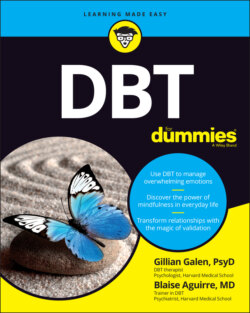Читать книгу DBT For Dummies - Gillian Galen - Страница 75
Switching self-destructive behaviors to healthy ones
ОглавлениеSelf-destructive behaviors are those that a person engages in that are likely to cause harm to the self, whether physical or emotional. The types of self-destructive behaviors that people bring to DBT when they are looking for therapy include suicide attempts, cutting, binge eating, dangerous driving, gambling, dangerous sexual behavior, substance abuse, and others.
In the short term, people who use these behaviors say that the behaviors bring them some relief from the pain of emotional suffering. This likely happens because certain chemicals are released into the brain. For instance, when people cut themselves, research shows that the brain releases a chemical that is a type of opiate. Drinking alcohol can lead to sedation because of alcohol’s effects on the brain. Driving dangerously is a risk-taking behavior that can cause the brain to release dopamine and cause the person to feel elated. All these dangerous behaviors can temporarily change how a person feels, but those who use them tend to discover that the effects are short-lasting and often leave them feeling worse in the long run, as many of these behaviors are ones that cross their values.
DBT focuses on the formation of healthier habits such as avoiding drugs and alcohol, getting to bed on time for a full night’s sleep, exercising, and focusing on healthy eating habits. What people who practice these healthier behaviors discover over time is that although these behaviors don’t have the immediate impact that the self-destructive behaviors have, they last longer and have an overall positive impact on general well-being, mental and physical health, and relationships. We dig deeper into addressing behaviors in Chapter 6.
